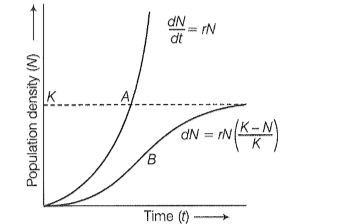The graph shows two types of population growth curve. A is exponential and B is logistic.

Which one of the following growth model considered as more realistic one?
1. Exponential growth curve
2. Logistic growth curve
3. Both the growth curves
4. None of the above

In an area, a population with large size individuals having long life span, more parental care and slow development was present. The type of population growth curve will be:
(1) S-shaped
(2) J-shaped
(3) Z-shaped
(4) All of these
The plants which can withstand with narrow and broad range of temperature tolerance respectively are:
1. monothermal and stenothermal
2. stenothermal and monothermal
3. stenothermal and eurythermal
4. stenothermal and mesothermal
Resemblance of one organism with its surroundings for protection and hiding is
(1) mimicry
(2) predation
(3) adaptation
(4) camouflage
Sinking of zooplankton during the day and rising to the surface at night is an example of
(1) circinal rhythm
(2) circadian rhythm
(3) tidal rhythm
(4) None of these
| Birth rate = B | Death Rate = D |
| Emigration = E | Immigration = I |
| Column-I | Column-II |
| A. Population is stable | I. B + I > D + E |
| B. Population is increasing | II. B + I = D + E |
| C. Population is decreasing | III. B + I < D + E |
| IV. B + E > D + I |
(1) A - II, B - I, C – III
(2) A - II, B - IV, C - III
(3) A - III, B - IV, C – I
(4) A - I, B - II, C - IV
Animals with a constant body temperature such as mammals and birds require more food than do animals with a changing body temperature such as reptiles and fish. Why?
(1) Much of the food is utilised to produce heat to keep warm
(2) Warm-blooded animals waste more food than cold-blooded animals
(3) Cold-blooded animals digest their food more efficiently than warm-blooded animals
(4) None of the above
Ecological niche is:
(1) The surface area of the ocean
(2) An ecologically adapted zone
(3) The physical position and functional role of a species within the community
(4) Formed of all plants and animals living at the bottom of a lake
I. Organisms living in oceans, lakes, and rivers face water-related problems.
II. Euryhaline can tolerate a wide range of salinities
III. Stenohaline are restricted to a narrow range of salinities
IV. No freshwater animals cannot live for long in seawater but sea animals can live in freshwater for a long time because of osmotic balance
V. The salt concentration (measured as salinity in parts per thousand), is less than 5 in inland water, 30-35 in the sea, and >100 in some hypersaline lagoons.
(1) All are correct
(2) All are false
(3) Only IV is wrong
(4) Only I, III, V are correct
Which of the following term implies the maintenance of relatively constant physical and chemical conditions with organisms?
(1) Homeostasis
(2) Adaptation
(3) Isometry
(4) Acclimation






